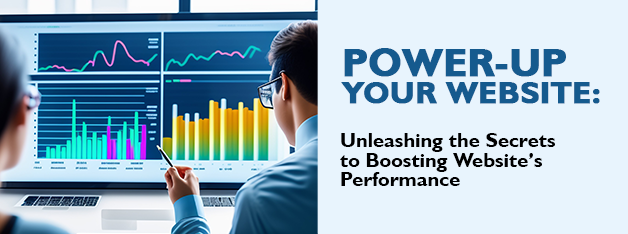Power-Up Your Website: Unleashing the Secrets to Boosting Website’s Performance

In today’s digital world, everything comes down to speed. It doesn’t matter if you have the most complex, interactive and good-looking website site if it takes forever to load. There are various reasons why your web pages may load slowly ,but no matter the cause slow website never helps to improve interaction and business but it can lead to lost opportunities and potential customers. But worry not! We’re here to provide you with some practical tips and tricks to optimize your website and take it to the next level. So, let’s dive right in!!
1. Optimize Images:
Images play a significant role in the visual appeal of your website, but they can also be a major factor in slowing it down. To optimize your images, make sure they are in the correct format (JPEG for photos and PNG for graphics) and compressed without losing too much quality. Numerous online tools are available that can help you achieve this, such as TinyPNG and Squoosh or you can use save for Web way.
2. Minify and Combine Files:
Minifying your CSS, JavaScript, and HTML files involves removing unnecessary characters like white spaces and comments. This reduces file sizes, resulting in faster loading times. Additionally, combining multiple CSS and JavaScript files into one can minimize HTTP requests, leading to improved performance. Tools like UglifyJS and CSSNano can assist in this process.
3. Enable Browser Caching:
Browser caching allows visitors to store some of your website’s files on their local device, reducing the need to download them again upon subsequent visits. By setting appropriate cache headers on your server, you can specify how long these files should be stored locally.We can use header such as Cache-control is an HTTP header used to specify browser caching policies in both client requests and server responsesThis way, returning visitors can experience faster load times. Remember to set a balance between caching duration and frequent content updates.You can leverage browser caching by modifying the .htaccess file. To do so, you can use an FTP client like FileZilla.
4. Implement Content Delivery Networks (CDNs):
A CDN is a network of servers distributed across different locations worldwide. By storing your website’s static files on these servers, users can access them from the server closest to their location, reducing latency. CDNs like Cloudflare, Google cloud CDN and Amazon CloudFront are among the best in the market and can significantly enhance your website’s performance, especially for global audiences.
5. Reduce number of HTTP Request Redirects:
Every redirect on your website adds an additional HTTP request, which slows down the page load time. Therefore, it’s essential to minimize the number of redirects.
- Our first step should be to eliminate requests that are simply unnecessary.
- You should remove any unnecessary images, JavaScript files, stylesheets, fonts, etc. If you are using a CMS like WordPress you should remove any unnecessary plugins as they often load additional files on each page.
- The next step is to optimize the rest. You should look into compressing your CSS and JavaScript files. Optimized websites often load all the required CSS and JavasScript in a single request for each.
This simple step can make a noticeable difference in your site’s overall performance.
6. Optimize Your Hosting:
Choosing the right hosting provider and plan is crucial for your website’s performance. Shared hosting might be cost-effective, but it can result in slightly slower load times due to resource sharing. Consider upgrading to a dedicated server or a virtual private server (VPS) to ensure better speed and reliability. If you are using WordPress, consider using a managed service that is well known for stable and high-performance hosting. You have three main options for hosting:
- Shared – traditionally the cheapest of the hosting options is a way to share the resources of the server with other customers.
- VPS – a virtual private server is significantly faster than a shared host but instead of using just one machine it uses multiple machines.
- Dedicated – dedicated servers are obviously the most expensive of the three and with this one, you basically rent an entire machine that can be usually configured to your wildest desire.
Of course, as always, you should measure your performance first before making the switch.
7. Regularly Monitor and Optimize:
Improving your website’s performance is an ongoing process. Regularly monitor your site’s speed using tools like Google PageSpeed Insights and GTmetrix. There are few more tools that provide insights and suggestions for further optimizations such as Google Analytics, Pingdom,etc.
Now, After doing all the tricks and taking all precautions When it comes to measuring the performance of interactive or any websites, there are several metrics to consider. One commonly used metric is the Google PageSpeed Insights score, which provides a numerical value based on various performance factors. While there isn’t an ideal score that universally defines good interactive website performance, a score of 90 or above is generally considered excellent. However, it’s essential to keep in mind that a high score doesn’t guarantee a flawless user experience. It’s crucial to prioritize the overall speed, responsiveness, and user satisfaction of your website, rather than focusing solely on achieving a specific score. Regular monitoring, optimization, and user feedback are key to continuously improving the performance of your interactive website.
So Congratulations! You’ve made it through our journey on improving your website’s performance. By implementing the tips & tricks suggested, you’ll be well on your way to providing your visitors with a faster, more enjoyable browsing experience. Remember, a well-optimized website not only boosts user satisfaction but also improves Business & search engine rankings. So, don’t wait any longer.!
